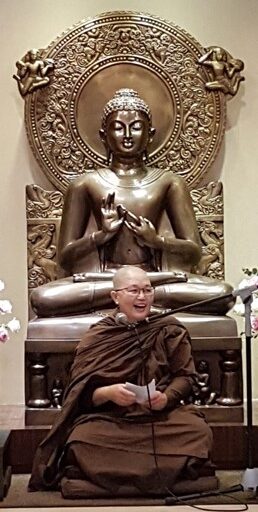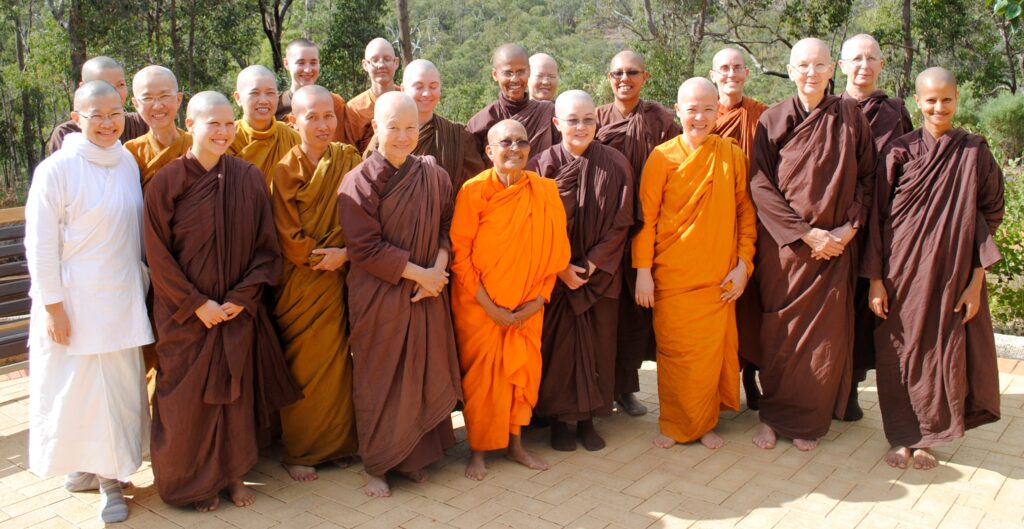Santi Forest Monastery is a Buddhist Nuns’ Monastery, a place of practice for nuns in the Theravada Forest tradition of Buddhism. It is set in the rugged bush ravines of the Southern Highlands of New South Wales, Australia. The traditional custodians of this land are the Gundungurra people.
Santi is closely affiliated to Dhammasara Nuns Monastery in Western Australia (website). Ajahn Hasapanna who is the abbot of Dhammasara and Assistant spiritual director of the Buddhist Society of Western Australia is also the Spiritual Director and abbot of Santi Forest Monastery.

Santi Monastery was created in the spirit of the Buddhist Forest Tradition. In the early years of Buddhism, monastics lived in the forest and would walk to a nearby village on daily alms round to sustain themselves.
In keeping with being alms mendicants, the monastery is supported entirely by the generous donations of the lay community. The monastics at Santi live simply, do not handle money and rely on generosity for sustaining their needs of food, shelter and medicine.
This dependency creates a firm bond between the monastic Sangha and the lay community. The Sangha cannot survive without the support of the lay community. This also ensures that the Sangha stays sincere to their spiritual aspirations and be worthy of support.
Lay people may visit during our daily open hours (10 am – 2 pm). Everyone is welcome regardless of religion, gender, sexual orientation or ethnicity. You do not need to be Buddhist to visit the monastery. There is a daily lunch time service that takes place at 11 am which anyone can participate in.
Buddhist practitioners with appropriate meditation experience may apply to stay as guests for short periods to practice, work, and experience the rhythm of monastic life here.
Organisation
The property is wholly owned by Santi Forest Monastery Incorporated, a not-for-profit charity. The management is carried out by a committee that is elected each year.
The current 2022 committee consists of:
Spiritual Director – Ajahn Hasapanna
Chairperson – Jen Smith
Secretary – Melanie James
Treasurer – Janith Perumathanthri
Public Officer – Harshani Udagami
Other Committee Members – Hoang Lam, Tammy Tran, Gillian Perret, Nishanthi de Silva and Chandi Jayasekara.
The committee meets quarterly, and is charged with ensuring the financial compliance and security of the monastery. They ensure all accounts are kept to the stringent requirements of the Australian charities laws, and are professionally audited each year. In addition, the committee often assists with various administrative duties in running the monastery, such as insurance, work safety, and so on.
If you have any inquiries in how the monastery is managed, or monastery finances, don’t hesitate to contact our office.
Key Committee documents
- Santi FM Constitution (download PDF)
- SFM Child Safety Framework (download PDF)
- Child Safety Code of Conduct (download PDF)
Please note that Santi Forest Monastery is owned and managed independently, and has no institutional affiliations.
Bhikkhunis
Santi is a monastery that supports the full ordination of women in Buddhism. Bhikkhunis, fully ordained Buddhist nuns, are traditional and have been a part of Buddhism since the very beginning. The Buddha himself established the order of bhikkhunis by ordaining his foster mother, Mahapajapati Gotami. Although not without their struggles, the nuns in Buddhist India flourished and reached the same lofty heights of spiritual perfection as the monks. The lineage of Theravada bhikkhunis is thought to have died out in Sri Lanka about 1,000 years ago during a period of war and famine.
The lineage of nuns has always remained intact in the northern Mahayana Buddhist school. In the late 1990’s monks and nuns from both Theravada and Mahayana Buddhism came together to revive full ordination for Buddhist women in the Theravada lineage. Since then bhikkhunis have been thriving and growing slowly across the globe.
In addition to Santi FM, there are two other Theravadin monasteries for bhikkhunis in Australia: Dhammasara in Perth, and Newbury Forest Monastery outside of Melbourne.
The bhikkhuni revival has met with opposition from conservative forces within the Theravadin Sangha. By focussing on the ‘purity’ of lineage and the supposed legal problems with bhikkhuni ordination, such opposition shows a lack of compassion for women and little understanding of the harmful effects of discrimination.
The eightfold path, the four noble truths, dependent origination, the way of wisdom and compassion: these are the true teachings of the Buddha. None of them have anything to do with gender.
This point was explicitly made, perhaps for the first time in human history, by a bhikkhuni in the Buddha’s time. In a remarkable dialogue preserved in the canonical Saṁyutta Nikaya, the fully Awakened Bhikkhuni Soma was challenged by Māra, the Buddhist Satan or Trickster. Playing the archetypal male chauvinist, he challenged:
“That state’s very challenging;
it’s for the sages to attain.
It’s not possible for a woman,
with her two-fingered wisdom.“
But Soma recognized him, and replied undaunted:
“What difference does womanhood make,
when the mind is serene,
and knowledge is present
as you rightly discern the Dhamma
Surely someone who might think:
‘I am a woman’, or ‘I am a man’,
Or ‘I am’ anything at all –
is fit for Mara to address.“

Teaching & Practice
Santi Forest Monastery is established with three primary goals.
- Living in monastic community based on Vinaya
- Study of the Buddha’s words in the early scriptures
- Meditation in seclusion
1. Living in community based on Vinaya
The Vinaya is the code of monastic conduct for Buddhist nuns and monks. It originates in the rules and procedures that were laid down by the Buddha. These were codified, extended, and organized in the generations following the Buddha’s passing away to create the Vinaya texts as we have them today. The primary texts used at Santi are those of the Pali Vinaya as passed down in the Theravada school, which are similar in most respects to the Vinayas preserved in Chinese and Tibetan translations.
Vinaya contains the pāṭimokkha list of training rules, 227 for bhikkhus, 311 for bhikkhunis in the Pali version. These rules and customs structure important aspects of monastic life, such as celibacy, wearing robes, not using money, use of food, and so on. Training according to such rules is strictly emphasized in the Forest Tradition, and monastics at Santi live accordingly.
The disciplinary aspect of Vinaya, however, is only one aspect of the monastics’ life. The Vinaya also sets out organizational principles to guide how a Sangha community should be run. According to the Vinaya, a community should be entirely egalitarian, without hierarchy or command, but with respect for elders and teachers. All important decisions are made by the community as a whole, and where possible, in consensus.
2. Study of the Buddha’s words in the early scriptures
At Santi we believe that it is essential for monastics and serious practitioners to have a thorough grounding in the essential teachings of the Buddha as laid down in the scriptures. All those residing at Santi are expected to acquire a good knowledge of the Buddhist Suttas and Vinaya. In addition, those who are interested in Pali, Buddhist history and so on, are encouraged to pursue these further.
3. Meditation in Seclusion
Like traditional forest monasteries, Santi is set in a large bush environment, perfect for meditation practice. Residents often stay in simple huts scattered around the property, and gather in the main house for teachings, meals, work, and so on. The monastery is planned and managed with emphasis on devotion to meditation in seclusion.
The practice of the Four Brahma Viharas (Divine Abidings): loving-kindness, compassion, sympathetic joy and equanimity are also essential cultivations for students of Buddha-dhamma, whether in private or together with others. Such attitudes and practices aid mutual respect, harmony and concord in community, and support the deepening of our meditation in solitude.
The Buddha constantly exhorted his students: ‘Here are roots of trees, here are empty huts – practice meditation! Do not be negligent! Do not regret it later!’ In his time, meditation was primarily a solitary matter, not performed in meditation halls in large groups. This practice is continued in many of the Thai forest monasteries today, whereas other centres have developed a strong group practice. At Santi, we predominantly follow the earlier model, which gives each individual the freedom to set their own pace in meditation. However, we also have some scheduled activities throughout the week.

